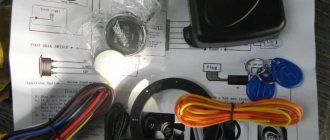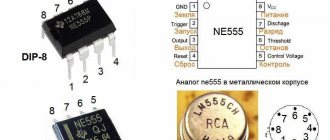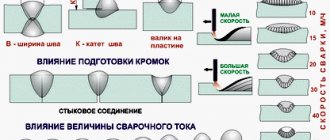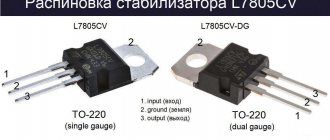A thyristor is an electronic component made from semiconductor materials, can consist of three or more pn junctions and has two stable states: closed (low conductivity), open (high conductivity).
This is a dry formulation, which for those who are just starting to master electrical engineering , means absolutely nothing. Let's look at the operating principle of this electronic component for ordinary people, so to speak, for dummies, and where it can be used. Essentially, it's the electronic equivalent of the switches you use every day.
There are many types of these elements, with different characteristics and different applications. Consider an ordinary single-operation thyristor.
The designation method on the diagrams is shown in Figure 1.
The electronic element has the following conclusions:
- anode positive terminal;
- cathode negative terminal;
- control electrode G.
What is a thyristor, its structure and designation on the diagram
A thyristor is a semiconductor element that has only two states: “open” (current flows) and “closed” (no current). Moreover, both states are stable, that is, the transition occurs only under certain conditions. The switching itself occurs very quickly, although not instantly.
This is what thyristors look like
In terms of its mode of action, it can be compared to a switch or a key. But the thyristor switches using voltage, and turns off when the current is lost or the load is removed. So the operating principle of a thyristor is not difficult to understand. You can think of it as an electrically controlled key. Well, not really.
A thyristor usually has three outputs. One control and two through which current flows. You can try to briefly describe the principle of operation. When voltage is applied to the control output, the circuit is switched through the anode-collector. That is, it is comparable to a transistor. The only difference is that in a transistor, the amount of current passed depends on the voltage applied to the control terminal. And the thyristor is either completely open or completely closed.
Appearance
The appearance of the thyristor depends on the date of its production. The elements from the times of the Soviet Union are metal, in the form of a “flying saucer” with three terminals. Two terminals - the cathode and the control electrode - are located on the “bottom” or “cover” (whichever side you look at). Moreover, the control electrode is smaller in size. The anode may be located on the opposite side of the cathode, or stick out sideways from under the washer that is on the body.
Two types of thyristors - modern and Soviet, designation on diagrams
Modern thyristors look different. This is a small plastic rectangle with a metal plate on top and three pins on the bottom. In the modern version there is one inconvenience: you need to look in the description which of the terminals is the anode, where is the cathode and the control electrode. Typically, the first is the anode, then the cathode and the one on the far right is the electrode. But this is usually the case, that is, not always.
Principle of operation
According to the principle of operation, a thyristor can also be compared to a diode. It will pass current in one direction - from the anode to the cathode, but this will only happen in the “open” state. In the diagrams, a thyristor looks like a diode. There is also an anode and a cathode, but there is also an additional element - a control electrode. Of course, there are differences in the output voltage (when compared with a diode).
The principle of operation of a thyristor in alternating voltage devices: at the output there is only the upper part of the sine wave
In alternating voltage circuits, the thyristor will pass only one half-wave - the upper one. When the lower half-wave arrives, it resets to the “closed” state.
Some features of Hi-Com triacs
Hi-Com triacs have a different internal structure from conventional triacs. One difference is that the two halves of the thyristor are better isolated from each other, which reduces their mutual influence. This provides the following benefits:
- Increasing the permissible dVCOM/dt value. This makes it possible to control reactive loads (in most cases) without the use of a damping device, without switching failures. This reduces the number of components, PCB size, cost, and eliminates energy dissipation losses from the damping device.
- Increasing the permissible dICOM/dt value. This significantly improves performance at higher frequencies and for non-sinusoidal voltages without the need to limit dICOM/dt using inductance in series with the load.
- Increasing the permissible dVD/dt value. Triacs are very sensitive at high operating temperatures. A high dVD/dt reduces the tendency for spontaneous switching from a non-conducting state to occur at the expense of dV/dt at high temperatures. This allows them to be used at high temperatures to drive resistive loads in kitchen or heating applications where conventional triacs cannot be used.
Due to the special internal structure, operation of Hi-Com triacs in quadrant 3+ is impossible. In most cases this is not a problem since it is the least desirable and least used quadrant. Therefore, replacing a conventional triac with a Hi-Com is almost always possible.
More detailed information on Hi-Com Triacs can be found in Philips specific documentation: “Factsheet 013 - Understanding Hi-Com Triacs” and “Factsheet 014 - Using Hi-Com Triacs”.
The principle of operation of a thyristor in simple words
Let's consider the principle of operation of a thyristor. The starting state of the element is closed. The “signal” to transition to the “open” state is the appearance of voltage between the anode and the control terminal. There are two ways to return the thyristor to the “closed” state:
- remove the load;
- reduce the current below the holding current (one of the technical characteristics).
In circuits with variable voltage, as a rule, the thyristor is reset according to the second option. Alternating current in a household network has a sinusoidal shape when its value approaches zero and a reset occurs. In circuits powered by DC sources, it is necessary to either forcibly remove the power or remove the load.
After removing the unlocking voltage, the thyristor remains in the open state (the light is on)
That is, the thyristor works differently in circuits with constant and alternating voltage. In a constant voltage circuit, after a short-term voltage appears between the anode and the control terminal, the element goes into the “open” state. Then there can be two scenarios:
- The “open” state is maintained even after the anode-control output voltage has disappeared. This is possible if the voltage applied to the anode control terminal is higher than the non-unlocking voltage (this data is in the technical specifications). The flow of current through the thyristor is stopped, in fact only by breaking the circuit or turning off the power source. Moreover, the shutdown/break of the circuit can be very short-lived. After the circuit is restored, no current flows until voltage is applied to the anode control terminal again.
- After removing the voltage (it is less than the unlocking voltage), the thyristor immediately goes into the “closed” state.
So in DC circuits there are two options for using a thyristor - with and without holding the open state. But more often they use the first type - when it remains open.
If we talk about the internal structure, these are three PNPN junctions
The operating principle of a thyristor in alternating voltage circuits is different. There, the return to the locked state occurs “automatically” - when the current drops below the holding threshold. If the voltage is constantly applied to the anode-cathode, at the output of the thyristor we obtain current pulses that occur at a certain frequency. This is exactly how switching power supplies are built. Using a thyristor, they convert the sine wave into pulses.
Let's sum it up
Comparing triac and thyristor voltage stabilizers with each other and with other types of devices, we can come to the following conclusions:
- both types of devices have both similar capabilities for voltage stabilization and almost identical disadvantages, one of which is stepwise adjustment and, as a consequence, a non-sinusoidal shape of the output signal;
- these stabilizers cannot protect equipment sensitive to network quality, as well as devices with electric motors;
- both devices are not much superior to relay voltage stabilizers in their operating parameters, but their cost is much higher;
- If thyristor and triac devices break down, repairing their electronic components will cost more than previous generations of voltage stabilizers operating on a similar principle.
Despite the fact that triac and thyristor stabilizers are still quite popular, they are gradually but surely being forced out of the market by a new type of device - inverter voltage stabilizers. Developed in 2015, these devices received the highest technical characteristics, including:
- higher stabilization accuracy (2%);
- continuous regulation of the mains voltage and, as a result, pure sine wave at the output;
- extended range of network input voltage (90-310 V);
- instant response speed;
- universal application.
Functionality check
You can check the thyristor either using a multimeter or by creating a simple test circuit. If you have the technical specifications in front of your eyes when making a test, you can at the same time check the resistance of the transitions.
One of the types: power T122-25
Testing with a multimeter
First, let's analyze the continuity test with a multimeter. We switch the device to dialing mode.
Digital multimeters have a continuity mode that allows you to test semiconductor devices
Next, we touch the pairs of terminals one by one with the probes:
- When connecting the probes to the anode and cathode, the device should show a break - “1” or “OL” depending on the multimeter. If other indicators are displayed in at least one direction, the thyristor is broken.
- There should be a slight resistance in one direction between the anode and the control electrode (lead). In the opposite direction there is a break. If there is either a break or slight resistance in both directions, the element is damaged.
Checking the thyristor using a multimeter. In the left picture, the display shows “1”, i.e. the resistance between the anode and cathode is too high and the device cannot detect it. In the right figure, the resistance is small, since a forward bias voltage is applied between the anode and the control electrode
Please note that the resistance value varies from series to series - you should not pay special attention to this. If you want to check the resistance of the transitions, look at the technical specifications.
Scheme for checking the performance of a thyristor with a multimeter
The figure shows the test diagrams. The figure on the far right is an improved version with a button that is installed between the anode and the control terminal. In order for the multimeter to record the current flowing through the circuit, briefly press the button.
Using a light bulb and a DC source (a battery will also work)
If you don’t have a multimeter, you can test the thyristor using a light bulb and a power source. Even a regular battery or any other constant voltage source will do. But the voltage must be sufficient to light the light bulb. You will also need resistance or a regular piece of wire. A simple circuit is assembled from these elements:
Scheme for testing a thyristor using a light bulb and a power source
- The plus from the power source is supplied to the anode.
- We connect a light bulb to the cathode, and connect its second terminal to the negative of the power source. The light does not light because the thermistor is locked.
- Briefly (using a piece of wire or resistance) connect the anode and the control terminal.
- The light comes on and continues to light even though the jumper is removed. The thermistor remains open.
- If you unscrew the light bulb or turn off the power source, the light bulb will naturally go out.
- If the circuit/power is restored, it will not light up.
Along with the test, this circuit allows you to understand the principle of operation of the thyristor. After all, the picture turns out to be very clear and understandable.
Types of thyristors and their special properties
Semiconductor technologies are still being developed and improved. Over several decades, new types of thyristors have appeared, which have some differences.
- Dinistors or diode thyristors. They differ in that they have only two outputs. They are opened by applying high voltage to the anode and cathode in the form of a pulse. They are also called “uncontrolled thyristors”.
- SCRs or triode thyristors. They have a control electrode, but the control pulse can be applied to: The control output and the cathode. Name - with cathode control.
- To the control electrode and anode. Accordingly, control of the anode.
Thyristors can be controlled from both the anode and cathode
There are also different types of thyristors according to the locking method. In one case, it is sufficient to reduce the anode current below the holding current level. In another case, a blocking voltage is applied to the control electrode.
By conductivity
We said that thyristors conduct current only in one direction. There is no reverse conduction. Such elements are called reverse-non-conducting, but there are not only such elements. There are other options:
- They have a low reverse voltage and are called reverse-conducting.
- With non-standardized reverse conductivity. They are installed in circuits where reverse voltage cannot occur.
- Triacs. Symmetrical thyristors. Conduct current in both directions.
They are distinguished mainly by the type of conductivity and control method
Thyristors can operate in switch mode. That is, when a control pulse arrives, supply current to the load. The load, in this case, is calculated based on the open voltage. The maximum power dissipation must also be taken into account. In this case, it is better to choose metal models in the form of a “flying saucer”. It is convenient to attach a radiator to them for faster cooling.
Classification by special operating modes
The following subtypes of thyristors can also be distinguished:
- Lockable and non-lockable. The operating principle of an unlockable thyristor is slightly different. It is in the open state when the plus is applied to the anode, the minus is on the cathode. It goes into a closed state when the polarity changes.
- Fast-acting. They have a short transition time from one state to another.
- Pulse. It transitions very quickly from one state to another, and is used in circuits with pulsed operating modes.
The main purpose is to turn on and off a powerful load using low-power control signals
The main area of use of thyristors is as an electronic key used to close and open an electrical circuit. In general, many common devices are built on thyristors. For example, a garland with running lights, rectifiers, pulsed current sources, rectifiers and many others.
Conductivity state
Unlike thyristors, a triac can be driven by either positive or negative current between the gate and T1. (The rules for VGT, IGT and IL are the same as for thyristors, see "Rule 1".) This property allows the triac to operate in all four sectors, as shown in Fig. 4.
When the gate is driven by DC or unipolar pulses with zero load current, negative gate current is preferred in the (3+,3–) quadrants for the following reasons. (The internal structure of triac junctions is characterized by the fact that the gate is furthest from the main conduction region in the 3+ quadrant.)
- A higher IGT value requires a higher peak IG.
- Longer delay between IG and load current requires longer IG duration.
- A low dIT/dt value can cause gate burnout when driving loads that produce a high dI/dt (cold incandescent lamp switching on, capacitive loads).
- The higher the IL (this also applies to quadrant 1–), the longer the IG duration will be needed for small loads, which will allow the load current to reach a value above IL from the beginning of the half cycle.
In standard AC phase control circuits, such as dimmers and speed controllers, the polarity of the gate and T2 are always the same. This means that control is always performed in the 1+ and 3– quadrants, in which the switching parameters of the triac are the same and the gate is most sensitive.
Note: 1+, 1–, 3– and 3+ is a four-quadrant notation used for brevity: instead of writing “MT2+, G+”, write 1+, etc. This data is obtained from the volt-ampere graph triac characteristics. A positive voltage T2 corresponds to a positive current through T2, and vice versa (see Fig. 5). Therefore, control is carried out only in quadrants 1 and 3. And the (+) and (–) indicators refer to the direction of the gate current.
Characteristics and their meaning
Some thyristors can switch very high currents, in which case they are called power thyristors. They are made in a metal case for better heat dissipation. Small models with a plastic body are usually low-power options that are used in low-current circuits. But, there are always exceptions. So for each specific purpose, the required option is selected. They select, of course, according to parameters. Here are the main ones:
- Maximum forward current. The value of the current that can flow through the anode-cathode. For powerful models it can reach hundreds of Amperes.
- Maximum permissible reverse current. Not indicated for all types, only for reverse-conducting ones.
- Direct voltage. This is the maximum permissible voltage drop in the on-state when the maximum current passes.
- Turn-on voltage. The minimum level of the control signal at which the thyristor will operate.
Example characteristics
- Holding current. If the current flowing through the anode-cathode is below this value, the device goes into a locked state.
- Minimum control signal current. If a current is supplied below this value, the element will not open.
- Maximum control current. If this parameter is exceeded, the pn junction will fail.
- Power dissipation. Determines the size of the connected load.
There is also a dynamic parameter - the time of transition from a closed to an open state. In some schemes this is important. The type of speed may also be indicated: by unlocking time or by locking time.










